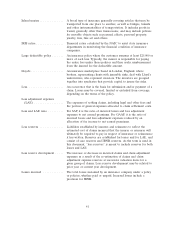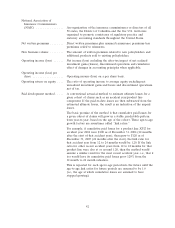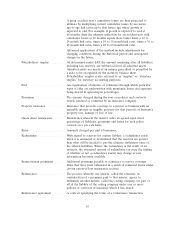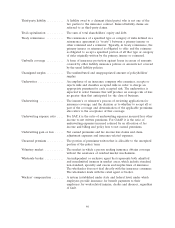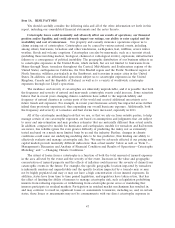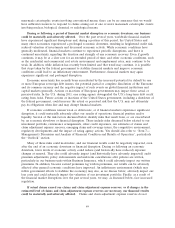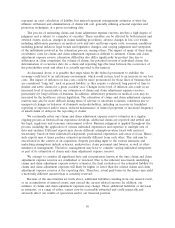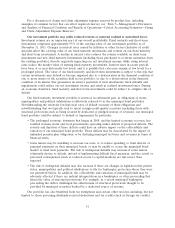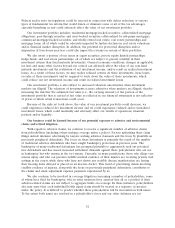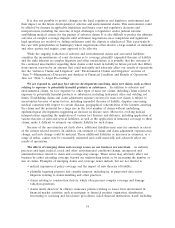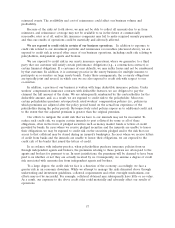Travelers 2011 Annual Report Download - page 62
Download and view the complete annual report
Please find page 62 of the 2011 Travelers annual report below. You can navigate through the pages in the report by either clicking on the pages listed below, or by using the keyword search tool below to find specific information within the annual report.represent an exact calculation of liability, but instead represent management estimates of what the
ultimate settlement and administration of claims will cost, generally utilizing actuarial expertise and
projection techniques, at a given accounting date.
The process of estimating claims and claim adjustment expense reserves involves a high degree of
judgment and is subject to a number of variables. These variables can be affected by both internal and
external events, such as: changes in claims handling procedures; adverse changes in loss cost trends,
including inflationary pressures on medical costs and auto and home repair costs; economic conditions
including general inflation; legal trends and legislative changes; and varying judgments and viewpoints
of the individuals involved in the estimation process, among others. The impact of many of these items
on ultimate costs for claims and claim adjustment expenses is difficult to estimate. Claims and claim
adjustment expense reserve estimation difficulties also differ significantly by product line due to
differences in claim complexity, the volume of claims, the potential severity of individual claims, the
determination of occurrence date for a claim and reporting lags (the time between the occurrence of
the policyholder event and when it is actually reported to the insurer).
As discussed above, it is possible that steps taken by the federal government to stabilize the
economy could lead to an inflationary environment, which could in turn, lead to an increase in our loss
costs. The impact of inflation on loss costs could be more pronounced for those lines of business that
are considered ‘‘long tail’’, such as general liability, as they require a relatively long period of time to
finalize and settle claims for a given accident year. Changes in the level of inflation also result in an
increased level of uncertainty in our estimation of claims and claim adjustment expense reserves,
particularly for long tail lines of business. In addition, inflationary pressures in medical costs may be
increased by the healthcare reform legislation. The estimation of claims and claim adjustment expense
reserves may also be more difficult during times of adverse or uncertain economic conditions due to
unexpected changes in behavior of claimants and policyholders, including an increase in fraudulent
reporting of exposures and/or losses, reduced maintenance of insured properties or increased frequency
of small claims or delays in the reporting of claims.
We continually refine our claims and claim adjustment expense reserve estimates in a regular,
ongoing process as historical loss experience develops, additional claims are reported and settled and
the legal, regulatory and economic environment evolves. Business judgment is applied throughout the
process, including the application of various individual experiences and expertise to multiple sets of
data and analyses. Different experts may choose different assumptions when faced with material
uncertainty, based on their individual backgrounds, professional experiences and areas of focus. Hence,
such experts may at times produce estimates materially different from each other. This risk may be
exacerbated in the context of an acquisition. Experts providing input to the various estimates and
underlying assumptions include actuaries, underwriters, claim personnel and lawyers, as well as other
members of management. Therefore, management may have to consider varying individual viewpoints
as part of its estimation of claims and claim adjustment expense reserves.
We attempt to consider all significant facts and circumstances known at the time claims and claim
adjustment expense reserves are established or reviewed. Due to the inherent uncertainty underlying
claims and claim adjustment expense reserve estimates, the final resolution of the estimated liability for
claims and claim adjustment expenses will likely be higher or lower than the related claims and claim
adjustment expense reserves at the reporting date. Therefore, actual paid losses in the future may yield
a materially different amount than is currently reserved.
Because of the uncertainties set forth above, additional liabilities resulting from one insured event,
or an accumulation of insured events, may exceed the current related reserves. In addition, our
estimate of claims and claim adjustment expenses may change. These additional liabilities or increases
in estimates, or a range of either, cannot now be reasonably estimated and could materially and
adversely affect our results of operations and/or our financial position.
50



